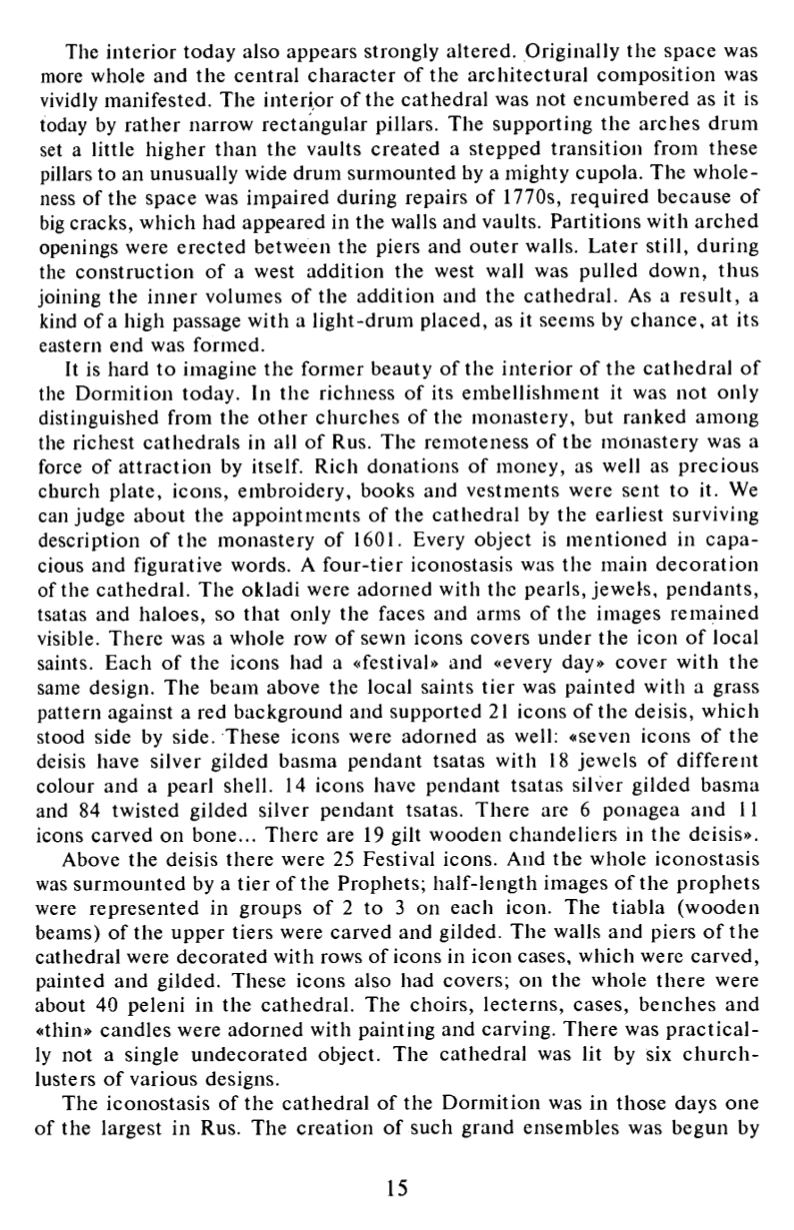

The interior today also appears strongly altered. Originally the space was
more whole and the central character of the architectural composition was
vividly manifested. The interior o f the cathedral was not encumbered as it is
today by rather narrow rectangular pillars. The supporting the arches drum
set a little higher than the vaults created a stepped transition from these
pillars to an unusually wide drum surmounted by a mighty cupola. The who le
ness of the space was impaired during repairs of 1770s, required because of
big cracks, which had appeared in the walls and vaults. Partitions with arched
openings were erected between the piers and outer walls. Later still, during
the construction of a west addition the west wall was pulled down, thus
joining the inner volumes o f the addition and the cathedral. As a result, a
kind of a high passage with a light-drum placed, as it seems by chance , at its
eastern end was formed.
It is hard to imagine the former beauty of the interior o f the cathedral of
the Dormition today. In the richness of its embellishment it was not only
distinguished from the o ther churches of the monastery, but ranked among
the richest cathedrals in all of Rus. The remoteness of the monastery was a
force of attrac tion by itself. Rich donations of money, as well as precious
church plate, icons, embroidery, books and vestments were sent to it. We
can judge about the appointments of the cathedral by the earliest surviving
description of the monastery of 1601. Every object is men tioned in c ap a
cious and figurative words. A four-tier iconostasis was the main decoration
of the cathedral. The okladi were adorned with the pearls, jewels, pendan ts,
tsatas and haloes, so that only the faces and arms of the images remained
visible. There was a whole row of sewn icons covers under the icon o f local
saints. Each of the icons had a «festival» and «every day» cover with the
same design. The beam above the local saints tier was painted with a grass
pattern against a red background and supported 21 icons of the deisis, which
stood side by side. These icons were adorned as well: «seven icons o f the
deisis have silver gilded basma pendant tsatas with 18 jewels o f different
colour and a pearl shell. 14 icons have pendant tsatas silver gilded basma
and 84 twisted gilded silver pendant tsatas. There are 6 ponagea and 11
icons carved on bone... There are 19 gilt wooden chandeliers in the deisis».
Above the deisis there were 25 Festival icons. And the whole iconostasis
was surmoun ted by a tier of the Prophets; half-length images o f the p rophets
were represented in groups o f 2 to 3 on each icon. The tiabla (wooden
beams) of the upper tiers were carved and gilded. The walls and piers o f the
cathedral were decorated with rows of icons in icon cases, which were carved,
painted and gilded. These icons also had covers; on the whole there were
about 40 peleni in the cathedral. The choirs, lecterns, cases, benches and
«thin» candles were adorned with painting and carving. There was p rac tica l
ly not a single undecorated object. The cathedral was lit by six chu rch -
lusters o f various designs.
The iconostasis of the cathedral of the Dormition was in those days one
of the largest in Rus. The creation of such grand ensembles was begun by
15















